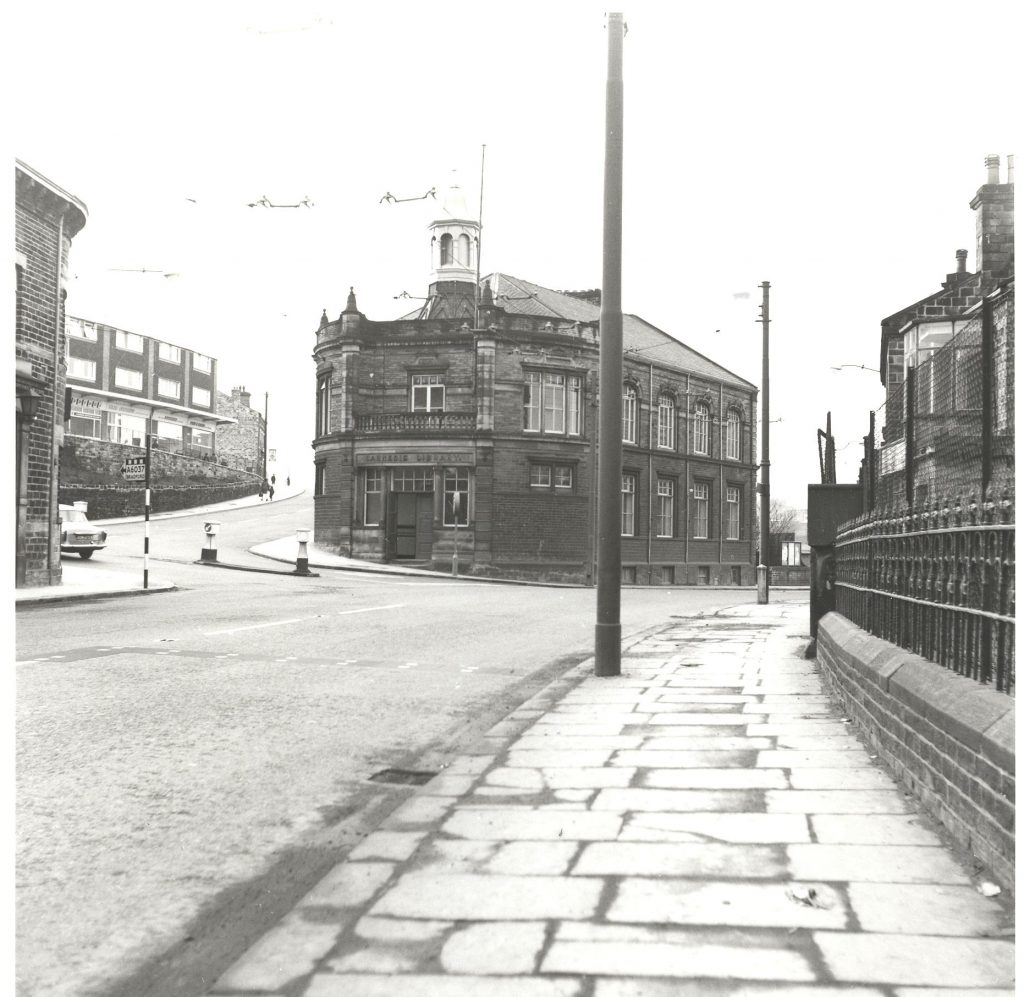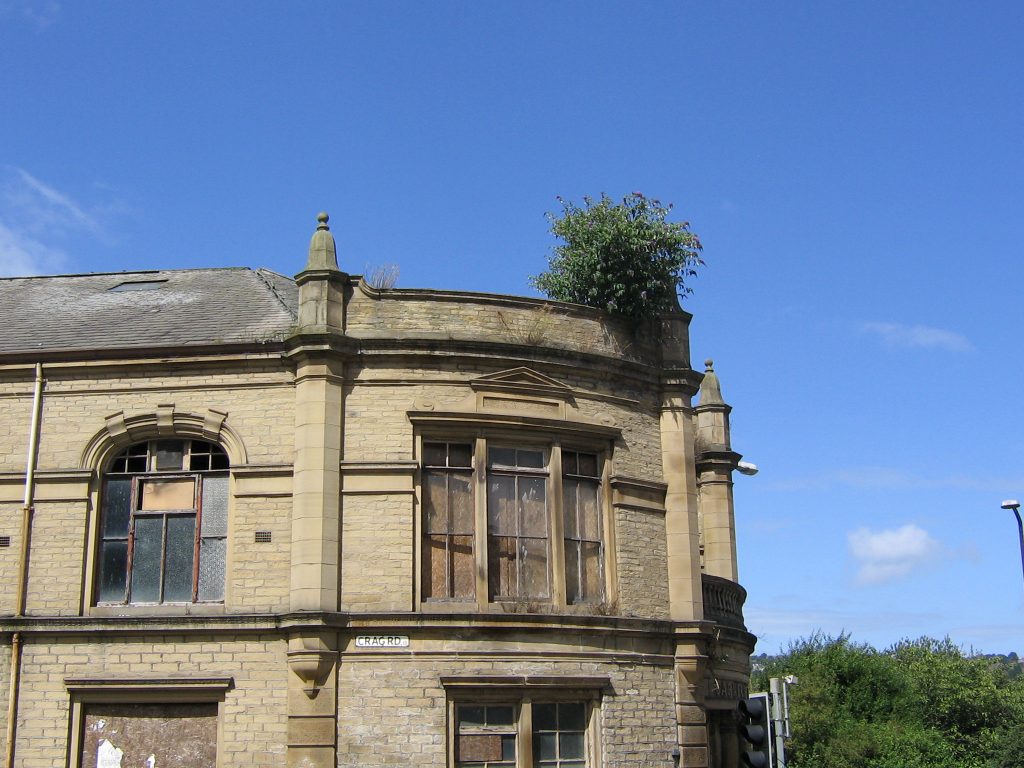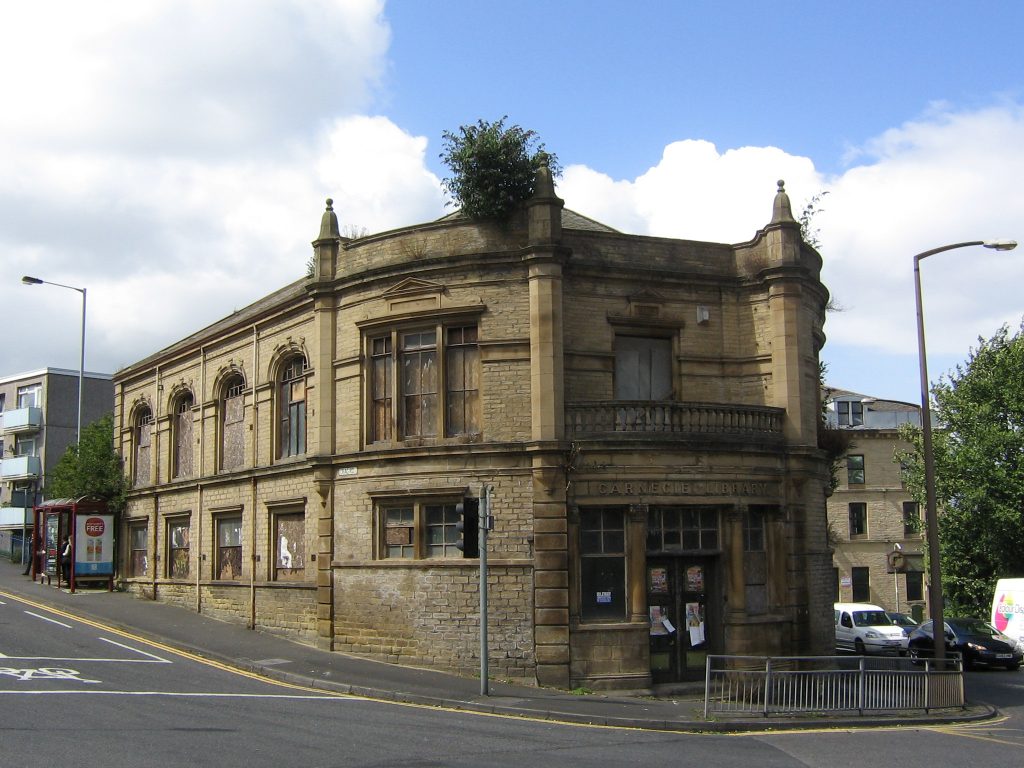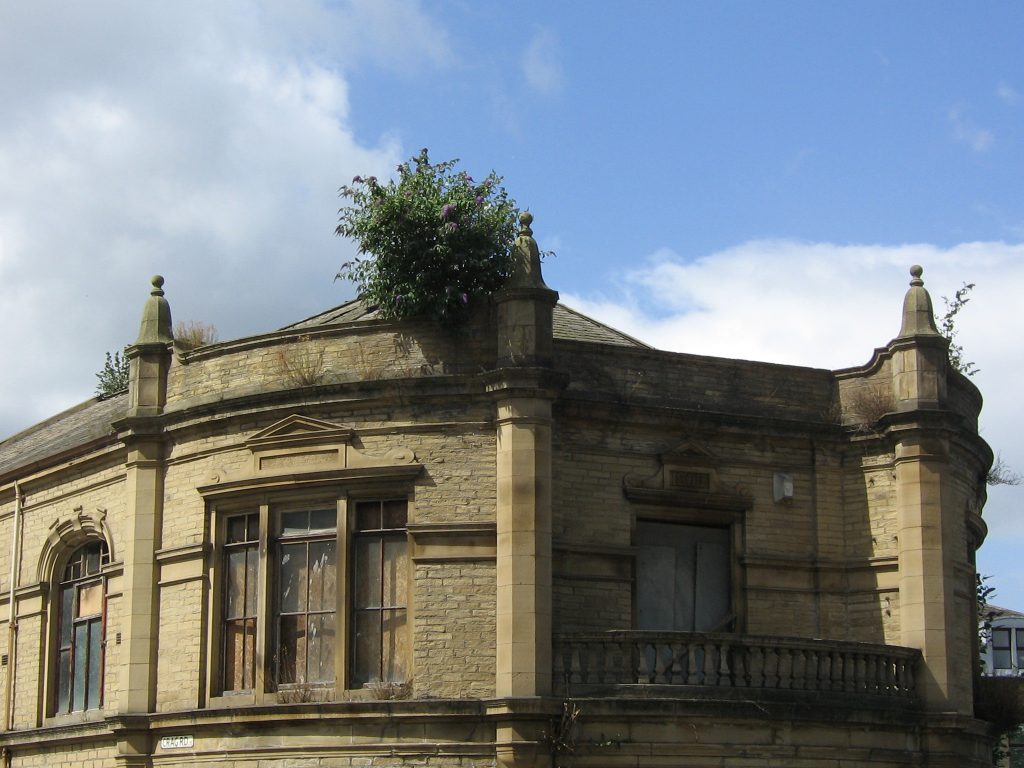On the road from Leeds to Shipley, I often admire the old Carnegie Library building at Windhill that stands empty and decaying. This fine brown-stone structure has a simple grandeur to it, with its pleasing curves, roof-pinnacles and balustrade-fronted gallery. It was one of many public libraries in the UK financed in Edwardian times by Scottish-American steel baron Andrew Carnegie. But despite Carnegie’s generosity, it strikes me that the likelihood of this building’s ultimate demise was inherent from its beginning.

Windhill Carnegie Library, Shipley, photo c1968, courtesy of Bradford Local Studies Library.
Windhill library was built in 1905, financed by a £3000 donation from Carnegie and designed by Bradford architect Abraham Sharp. At that time it was not a middle-of-nowhere relic complicating a busy traffic junction, but an integral part of a vibrant local centre of shops, pubs and other community institutions. On opening, the place was distinguished enough to merit a column in The Builder magazine that described its internal splendour.
The front doors apparently led into a vestibule and a hexagonal entrance-hall whose flooring consisted of terrazzo mosaic tiling. Beyond this was the main lending library, flanked by a reference library to one side and a reading room to the other, furnished in varnished pitch-pine and teak. The librarian’s room was situated in a central position on a raised platform to “afford full supervision” (it was, after all, a more paternalistic age!). There was space for 8,000 books and 50 readers. Upstairs there was a student’s room, a ladies’ room, a patent journal room, toilets for both sexes, a tea-room and a lecture hall accommodating 150 persons. Sliding partitions enabled the whole floor to be opened out for greater numbers if need be.
By contrast, I was able to peer inside the library on a recent visit to observe a derelict shell gutted of its original features. Paint is peeling from the ceiling and dangling in shards, and rubbish is strewn across the exposed concrete base. Most of the window glass has been replaced by haphazard boarding, but the building is not weatherproof since several frames on the upper story gape empty. Much of the external woodwork is rotting, and areas of stonework are buckling and crumbling. Somewhere along the line it has lost its tower, and the place may be said to have joined the ranks of those neglected “botanical buildings” that harbour cultures of vegetation growing out of their guttering.



My photos, taken 8th August 2016
Given how well-appointed the structure was initially, it is interesting to note that Carnegie’s contribution to such institutions went no further than funding the actual building work. Also, given his control-freakery regarding the more prestigious philanthropic foundations that bore his name, it is surprising how much the relevant local authorities were simply given the money and told to get on with.
Working through his secretaries, Carnegie stipulated only that local authorities provide the land, set aside ten percent of the building’s cost annually for its maintenance, and sign-up to the Public Libraries Act of 1850 which enabled them to raise a penny rate for the provision of books. No architectural uniformity was imposed, nor was any charter issued setting out how the actual business of a Carnegie library was to be conducted. Concerning grants to build public libraries in New York City, Carnegie declared: “I give you the seed, cultivate it as you will.”
Deciding which localities were to benefit from his bounty seems similarly lax. The field was thrown open to UK applications in 1902, and hopeful local authorities were to send requests to Carnegie’s secretaries. If approved the council signed a pledge agreeing to the basic Carnegie terms, and the money arrived by instalments as work progressed. The amount given to a town was based on the size of its civic population.
The first Carnegie Library in England (which, unlike Windhill, is protected by a Grade II listing) was opened in 1904 at Keighley, and it got £10,000 (to Windhill’s £3,000), which stretched to mounting a marble bust of Carnegie on a pedestal within. Apparently Carnegie toyed with Sir Swire Smith, who was associated with the Keighley application, by initially offering him $50,000 dollars when Smith was staying with the magnate at his Scottish castle of Skibo, only to rescind the offer next morning with a carefree quip.
This incident suggests that Carnegie enjoyed the power his money gave him over people. “The man who dies rich,” he however declared, “dies disgraced.” Free libraries were just one beneficiary of his untiring efforts to divest himself of his fortune towards the end of his life, but many questioned the philanthropic sincerity of someone who had reputedly made his pile ruthlessly and without regard for workers’ rights.
Another ground for criticism of Carnegie returns us to the present plight of the Windhill library building. Because he did not settle permanent endowment funds on such institutions that could finance books, staff and upkeep, Carnegie did not safeguard them against changing times. He built 660 free libraries in Great Britain in total, but a report on UK library provision in 1914 found that some were underprovided as regards the quantity and quality of their book-stock. Revenue from the penny rate was simply insufficient in some cases, and one commentator talked of “overbuilding” leaving many smaller towns with “collections of bricks rather than of books.”
The upstairs floor at Windhill apparently came to be used as a function hall and ballroom, but when the new Shipley library was opened in 1985 the building closed. It was reputedly leased to the Irish Folk Music Society and a Pentecostal church at one time or another, but it was sold to private owners in 2006 since when it has been neglected. The lack of a permanent endowment may prove fatal to its survival. I’ve just looked at a current photo of Carnegie Hall in New York City and am unsurprised to find that it does not have wild bushes growing from its skyline.
Sources & Acknowledgements:
The Builder, 27th January, 1906, p. 99; Post Office Bradford Directory, 1909; Carnegie by Peter Krass, 2002; Little Boss: a life of Andrew Carnegie by James A. Mackay, 1997; Books for the People: An Illustrated History of the British Public Library by Thomas Kelly,1977; The Cambridge History of Libraries in Britain and Ireland Vol III 1850-2000; Oxford Dictionary of National Biography entry on Andrew Carnegie; A file of various press sources available at Bradford Local Studies Library.
I am grateful for the help given to me by staff at Bradford Local Studies Library and Keighley Local Studies Library.
